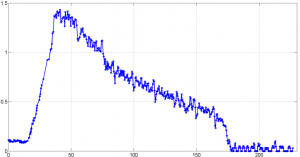Industries
Modeling of alcoholic fermentation in champagne-production context
05/12/2019 | Written by: Robert David
Categorized: Data & AI | Generic | Industries
Share this post:
By Technord, IBM partner “This is champagne”
One of the main challenges in the agro-food production is to handle the variability of the raw matters to deliver a final product meeting the quality specifications. The champagne production is a typical example: the quality of the main substrate, the grapes juice, depends on the yearly weather, the vineyard practices, the culture soil. It means that the fermentation will also behave differently following the juice composition (sugar and nitrogen amounts, turbidity, among others).
It is therefore of interest to monitor the fermentation and anticipate their behaviour to ensure the workflow in production. The dynamical modeling and representation of the main measurement, the CO2 flux, is the first step towards an automated ‘live’ management of these fermentations.

Figure 1
Hexose sugars are transformed by the yeast into ethanol and CO2 and it has been observed that the generated CO2 flux is a reliable representation of the fermentative activity. CO2 flux increases with the exponential growth of biomass reach a peak of activity and then decreases as the ethanol produced by the yeast will paradoxically inhibit the latter.
The fermentation ends when sugar is depleted and there is consequently no CO2 flux anymore. An illustrative example can be found in Figure 1.
Moreover, corrective actions can be taken to avoid sluggish fermentation and preserve future wine quality. Micro-oxygenation has a positive impact and is studied to better understand the metabolic mechanisms that are involved.
Automated monitoring of the fermentation
The challenge for big champagne houses is to ensure that all the fermentations proceed properly. The grapes harvest is done in less than 1 month and therefore hundreds of fermentation tanks have to be monitored. The variability in the grape components implies that every fermentation is different and a lot of parameters will influence this latter. The volume and the urge of production do not allow oenologists to check efficiently every tank during this period and some fermentations can be failed or mediocre.
Automated monitoring of the fermentation associated with predictions is, therefore, a valuable tool for the producers. The operational gain can be easily translated into a financial gain.
The IBM partner Technord has developed a mathematical simulator that can provide predictions of CO2 flux in ‘live’ conditions:
- The first upcoming measurements are analysed to determine when the fermentation starts.
- When this start is detected, the following measurements are used to follow a decision tree that will indicate which set of parameters to use for the model equations;
- The model provides predictions of the CO2 flux for the whole fermentation and allows to anticipate if this fermentation will present issues or not, based on the predicted peak of activity. The end of fermentation is also predicted to prepare the next steps of the workflow.

Figure 2
IBM Watson IoT allowed to calculate fast enough the predictions and provide a ‘live’ web dashboarding to monitor and predict the behaviour of the fermentation for the end-user, see Figure 2.
The smart predictive sensor that Watson provides is an example of innovative AI into the agro-food field!

Head of Data Science/Analytics/Modeling, Technord
Automate work and accelerate business growth
Many companies need help to navigate the rapid changes that define today’s business environment. To improve their responsiveness and flexibility, they are looking for new ways of conducting business, rethinking their processes, and investing in digital transformation projects to increase the robustness of their operations. They rely on business automation technologies to cut out repetitive […]
Sustainability and the technologies enabling the transition
Creating a sustainable future demands significant technological innovation to decarbonize society, restore biodiversity and ecosystem health, foster thriving oceans for sustenance and economic growth, remove atmospheric carbon, transition to sustainable agriculture, and advance eco-friendly cities that align with our vision for a better future. Generative AI has achieved much in recent years and now surpasses […]
Data-driven asset management with IBM Maximo Application Suite and Cloud Pak for Data
IBM has enhanced its Enterprise Asset Management platform, IBM Maximo Application Suite (MAS), with IBM Cloud Pak for Data: a supporting platform which provides a framework for combining a variety of data from different areas of an organization. How does IBM Cloud Pak for Data help organizations gain additional asset management insights from available data? […]


